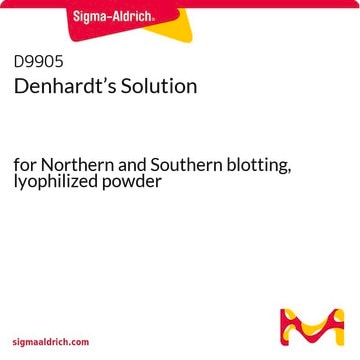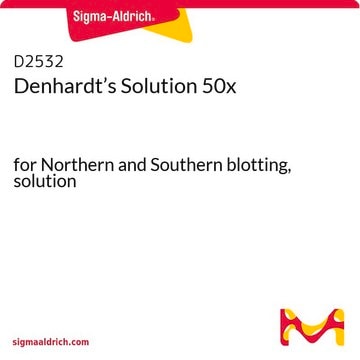推荐产品
包装
pack of 1 ea
制造商/商品名称
Cytiva RPK0325
运输
dry ice
储存温度
−20°C
一般描述
DNA microarrays can be used to measure the expression levels of large numbers of genes simultaneously (gene expression profiling), or to genotype multiple areas of a genome (SNP arrays), with variable coverage or resolution depending how many DNA “spots” cover those areas.
A DNA microarray (or DNA chip) is a collection of microscopic DNA spots arranged in an array and attached to a solid surface, usually a microscope slide. Each DNA spot contains a specific DNA sequence, known as a probe, or hybridization probe. These can be short sections of a gene or other DNA elements and are often used to hybridize a cDNA sample (called the target) under high-stringency conditions. This is where it is useful to have a standardized, proprietary nucleic acid hybridization solution, to get as high as possible a signal to noise ratio for genes which are less highly expressed and allowing this expression to be semi-quantified.
Probe-target hybridization is usually detected and quantified by detection of fluorophore- or chemiluminescence-labeled targets to determine relative abundance of nucleic acid sequences in the target.
When looking at gene structure (e.g. copy number) the hybridization is with DNA rather than cDNA, and the technique is known as array CGH, which is used in looking at copy numbers of genes involved in different cancers, and in looking at genetic diseases.
A DNA microarray (or DNA chip) is a collection of microscopic DNA spots arranged in an array and attached to a solid surface, usually a microscope slide. Each DNA spot contains a specific DNA sequence, known as a probe, or hybridization probe. These can be short sections of a gene or other DNA elements and are often used to hybridize a cDNA sample (called the target) under high-stringency conditions. This is where it is useful to have a standardized, proprietary nucleic acid hybridization solution, to get as high as possible a signal to noise ratio for genes which are less highly expressed and allowing this expression to be semi-quantified.
Probe-target hybridization is usually detected and quantified by detection of fluorophore- or chemiluminescence-labeled targets to determine relative abundance of nucleic acid sequences in the target.
When looking at gene structure (e.g. copy number) the hybridization is with DNA rather than cDNA, and the technique is known as array CGH, which is used in looking at copy numbers of genes involved in different cancers, and in looking at genetic diseases.
特点和优势
- Includes a blend of proprietary components to provide highly reproducible, high-quality automated and manual DNA microarray hybridizations
- Hybridization rate enhancers improve the detection of rare targets
- Proprietary blocking agents minimize non-specific background
储存及稳定性
Please be aware this product may be shipped 90 days before the expiration date. For more information on the batch specific expiration date, please contact technical service.
分析说明
To view the Certificate of Analysis for this product, please visit www.cytiva.com.
储存分类代码
12 - Non Combustible Liquids
我们的科学家团队拥有各种研究领域经验,包括生命科学、材料科学、化学合成、色谱、分析及许多其他领域.
联系客户支持







